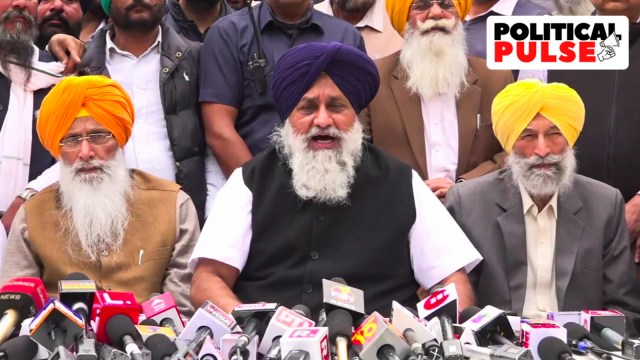© The Indian Express Pvt Ltd
Latest Comment
Post Comment
Read Comments
 Shiromani Akali Dal (SAD) president Sukhbir Singh Badal. (PTI Photo)
Shiromani Akali Dal (SAD) president Sukhbir Singh Badal. (PTI Photo)With a flowing grey beard and a blue turban, these days Shiromani Akali Dal (SAD) president Sukhbir Singh Badal is almost a spitting image of his father and five-time Punjab Chief Minister Parkash Singh Badal.
Since the death of the SAD patron on April 25 last year, Sukhbir is facing the prospect of filling his father’s big shoes and has received advice from many quarters on how he should carry forward his legacy. But in his speeches, the former Punjab Deputy CM has often admitted that it is impossible to emulate his father.
“Vadde Badal saab banana impossible hai … par main uhna vaang Punjab ate quom layi har kurbani den layi tayyar haan (It is impossible to become like senior Badal sahab but I assure you I am ready to sacrifice everything for Punjab and the community, just like him),” he had said in his village on March 10 while speaking on the occasion of his father’s first death anniversary.
State BJP president Sunil Jakhar urged Sukhbir to follow in his father’s footsteps while pointing out that he has a large responsibility on his shoulders. “Parkash Singh Badal was a statesman to the core. The new generation must learn from him. Josh de naal hosh rakho (Keep your feet grounded even in excitement),” he said at the event, calling for leaders to cultivate patience in politics.
Though the SAD president faces the uphill task of maintaining the legacy of his father, who was seen to be a “political university in himself”, since last December he seems to be evolving politically. From changing his appearance to almost appear like his father and exuding patience while fiercely attacking opponents to making efforts for Panthic unity, Sukhbir set the ball rolling on December 14 when he issued a public apology for not being able to apprehend the culprits of the 2015 sacrilege case while the SAD was in power in alliance with the BJP.
Sukhbir also brokered a truce with SAD (Sanyukt) leader Sukhdev Singh Dhindsa who had walked out of the SAD in 2018 with other leaders such as the late Ranjit Singh Brahmpura over the handling of the sacrilege case. This eventually led to the merger of their parties on March 6. While welcoming Dhindsa back into the SAD, the former Deputy CM targeted Punjab CM Bhagwant Mann and advised him to watch videos of Parkash Singh Badal to learn how to remain calm while speaking with political rivals in the Assembly.
“The SAD is a 103-year-old regional party. Badal sahab (Parkash) served it for 70 years. I can see the same dedication in all his team members such as Dhindsa, Balwinder Singh Bhunder and others. There is so much to learn from them. As the senior most member of the party after Badal sahab, I request Dhindsa ji to be the patron of the party,” Sukhbir said.
Similarly, at an event on March 14 organised to welcome back former Shiromani Gurdwara Parbandhak Committee (SGPC) chief Bibi Jagir Kaur into the party fold, the SAD chief said the entire Akali Dal family was now united and ready to take on the Aam Aadmi Party (AAP) to “save Punjab and Punjabis”. Kaur, who was the first woman to head SGPC, was expelled from the SAD last November over alleged anti-party activities and attempts to “break the SGPC”.
Nowadays, Sukhbir refers to his father in almost all his speeches and never forgets to remind people of the work done by the five-time CM, as he tries to reverse the party’s shrinking electoral footprint. He also often reminds them that like his father, he too spends time regularly at the Badal home to address grievances. “There is so much to learn from him. All I can do is continue making efforts to be like him,” the SAD chief recently said.
SAD insiders said Sukhbir had become accessible and now is open to suggestions from party workers even as he is judicious in making new appointments.
Meanwhile, the SAD has yet to announce its list of candidates amid talks of an alliance with the BJP. Sukhbir has evaded the question, criticising the media for being more bothered about the possible alliance than the party. “We are ready for all 13 Lok Sabha seats,” he said recently. In 2019, the SAD won two Lok Sabha seats, four less than five years earlier, and its vote share was 27.76% while the NDA’s total vote share was about 37%. The Congress, which won eight constituencies, had a vote share of 40.58%.


